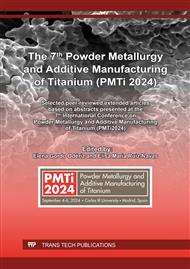[1]
D. G. Morris and M. A. Mun˜oz-Morris. Intermetallics: Past, present and future. Revista de Metalurgia (Madrid), SPEC. VOL.(c):498–501, 2005.
Google Scholar
[2]
K. Kothari, R. Radhakrishnan, and N. M. Wereley. Advances in gamma titanium aluminides and their manufacturing techniques. Progress in Aerospace Sciences, 55:1–16, 2012.
DOI: 10.1016/j.paerosci.2012.04.001
Google Scholar
[3]
A. Lasalmonie. Intermetallics: Why is it so difficult to introduce them in gas turbine engines? Intermetallics, 14(10-11):1123–1129, 2006.
DOI: 10.1016/j.intermet.2006.01.064
Google Scholar
[4]
F. Appel, J. D. H. Paul, and M. Oehring. Gamma Titanium Aluminide Alloys: Science and Technology. Wiley-VCH Verlag GmbH & Co. KGaA, Weinheim, Germany, 2011.
DOI: 10.1002/9783527636204
Google Scholar
[5]
H. Clemens and H. Kestler. Processing and applications of intermetallic γ-TiAl-based alloys. Advanced Engineering Materials, 2(9):551–570, 2000.
DOI: 10.1002/1527-2648(200009)2:9<551::aid-adem551>3.3.co;2-l
Google Scholar
[6]
R. M. Moreno. In situ analysis of the high temperature deformation and fracture mechanisms. PhD thesis, University Carlos III of Madrid, May 2014.
Google Scholar
[7]
B. P. Bewlay, S. Nag, A. Suzuki, and M. J. Weimer. TiAl alloys in commercial aircraft engines. Materials at High Temperatures, 33(4-5):549–559, 2016.
DOI: 10.1080/09603409.2016.1183068
Google Scholar
[8]
H. Clemens and S. Mayer. Intermetallic titanium aluminides in aerospace applications – processing, microstructure and properties. Materials at High Temperatures, 33(4-5):560–570, 2016.
DOI: 10.1080/09603409.2016.1163792
Google Scholar
[9]
B. Liu and Y. Liu. Powder metallurgy titanium aluminide alloys. Elsevier Inc., 2015.
Google Scholar
[10]
C. Leyens and M. Peters. Titanium and titanium alloys: Fundamentals and applications. Wiley- VCH, 2003.
Google Scholar
[11]
U. Habel and B. J. McTernan. HIP temperature and properties of a gas-atomized γ-titanium aluminide alloy. Intermetallics, 12(1):63–68, 2004.
DOI: 10.1016/j.intermet.2003.08.006
Google Scholar
[12]
G. Cao, L. Fu, J. Lin, Y. Zhang, and C. Chen. The relationships of microstructure and properties of a fully lamellar TiAl alloy. Intermetallics, 8(5-6):647–653, 2000.
DOI: 10.1016/s0966-9795(99)00128-4
Google Scholar
[13]
R. T. Zheng, G. A. Cheng, G. X. Cao X. J. Li, Y. G. Zhang L. F. Fu, and C. Q. Chen. The relationship between fracture toughness and microstructure of fully lamellar TiAl alloy. Journal of Materials Science, 42(4):1251–1260, 2007.
DOI: 10.1007/s10853-006-1382-z
Google Scholar
[14]
R. Gerling, H. Clemens, and F. P. Schimansky. Powder metallurgical processing of intermetallic gamma titanium aluminides. Advanced Engineering Materials, 6(1-2):23–38, 2004.
DOI: 10.1002/adem.200310559
Google Scholar
[15]
D. Y. Seo, L. Zhao, and J. Beddoes. Microstructural evolution during heat treatments in Ti-45 and 47Al-2Nb-2Mn + 0.8 vol% TiB2 XDTM alloys. Materials Science and Engineering A, 329-331:130–140, 2002.
DOI: 10.1016/s0921-5093(01)01546-5
Google Scholar
[16]
M. Su, Z. Lang, L. Zheng, J. Yan, K. Guan, and H. Zhang. Effect of heat treatment on microstructures and mechanical properties in a full lamellar TiAl alloy. Materials Science and Engineering A, 15(3):455–460, 2012.
DOI: 10.1590/s1516-14392012005000059
Google Scholar
[17]
T. Novoselova, S. Malinov, and W. Sha. Experimental study of the effects of heat treatment on microstructure and grain size of a gamma TiAl alloy. Intermetallics, 11(5):491–499, 2003.
DOI: 10.1016/s0966-9795(03)00028-1
Google Scholar
[18]
G. Wegmann, R. Gerling, and F. Peter Schimansky. Temperature induced porosity in hot isostatically pressed gamma titanium aluminide alloy powders. Acta Materialia, 51(3): 741–752, 2003.
DOI: 10.1016/s1359-6454(02)00465-2
Google Scholar
[19]
Z. Zhang, Q. Sun, C. Li, and W. Zhao. Theoretical calculation of the strain-hardening exponent and strength coefficient of intermetallic gamma titanium aluminide alloys. Journal of Materials Engineering and Performance, 15(1):22–26, 2006.
DOI: 10.1361/10599490524057
Google Scholar
[20]
K. Young-Won. Intermetallic alloys based on gamma titanium aluminide. JOM, 41(7): 24–30, 1989.
DOI: 10.1007/bf03220267
Google Scholar



